What The Teachers Are Asking For

A stunning image of just how many teachers are marching to the Arizona State Capitol.
The teacher walkouts began in West Virginia, where public school employees were woefully underpaid and faced spiraling health care costs. They stayed out for nine days and won a 5 percent salary increase. Oklahoma teachers soon followed suit, seeking a raise and increased education funding for their schools and students. They too won concessions. Then came Kentucky teachers, angry because the state planned to restructure their pensions for the worse. Starting Thursday, public school teachers in Arizona will walk out. On Friday several districts in Colorado will be closed.
What is happening? Almost all these states are red states, controlled by Republicans. Almost all are right-to-work states, with weak unions. Yet in these states, teachers have said enough is enough. Typically, it has not been their unions that spurred the walkouts. Time and again, the uprisings were from the grass roots, beginning with a page on social media calling other teachers to get together and protest working conditions.
As educators often say, teachers’ working conditions are students’ learning conditions. It is not merely low pay that is sending the teachers into the streets: It is also large class sizes, obsolete textbooks, crumbling buildings and the fact that many teachers — already underpaid — are shelling out $1,000 or more each year to pay for classroom supplies that their schools no longer provide.
In short, teachers are calling on their legislatures to fund their schools and their students adequately.
For years, the red states have been working from a common playbook: low taxes for corporations and budget cuts for schools, universities and other public services.
The result? Many teachers have to work two or three jobs — sometimes even more ― to feed their families, pay their mortgages and make their car payments. Some move in with continue reading: What The Teachers Are Asking For | HuffPost:



